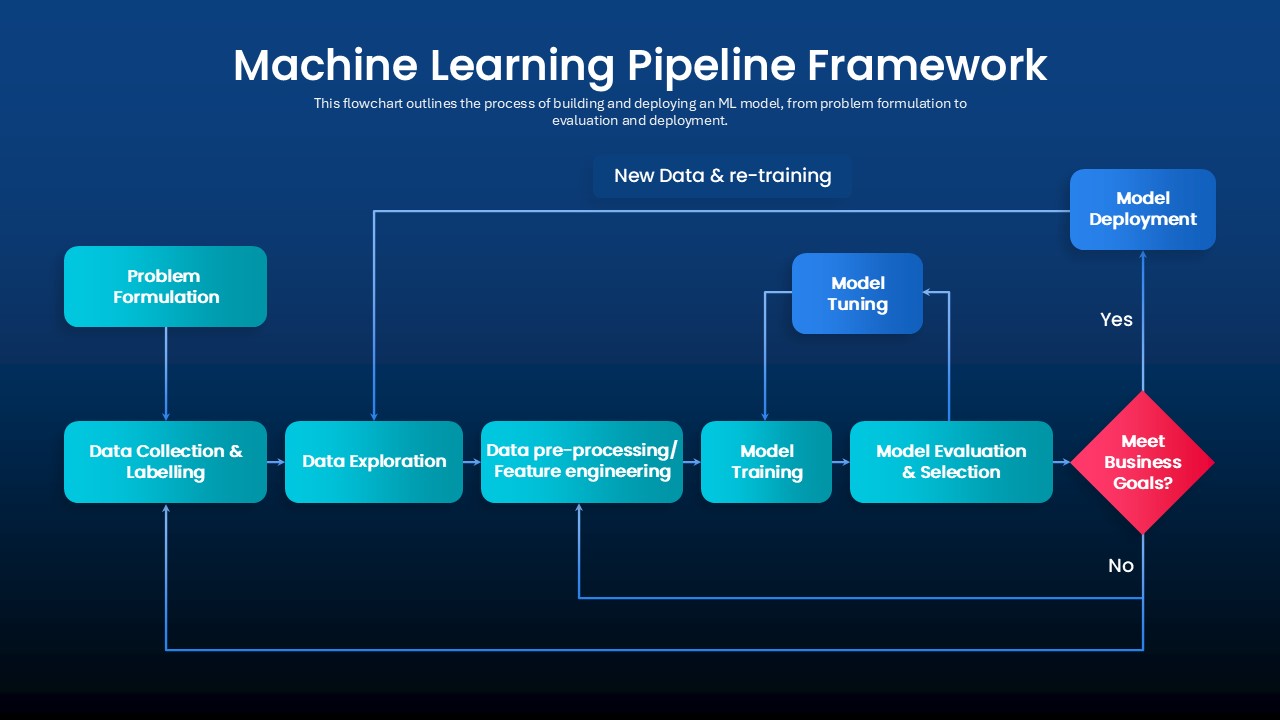machine-learning-pipeline-framework-dark-template-powerpoint-google-slides

Description
This slide delivers a comprehensive, end-to-end machine learning pipeline framework designed to guide audiences from initial problem formulation through iterative model deployment. A sleek horizontal flowchart uses gradient-filled shapes—teal blocks for data-driven phases, blue blocks for modeling stages, and a red decision diamond—to distinguish each process step, from “Problem Formulation” and “Data Collection & Labelling” to “Data Exploration,” “Data Pre-processing/Feature Engineering,” “Model Training,” “Model Evaluation & Selection,” “Model Tuning,” and final “Model Deployment.” Crisp, uni-directional arrows and looping connectors visually reinforce the iterative nature of retraining and data refinement. Key touchpoints such as the “Meet Business Goals?” decision gate are highlighted with bold typography and color contrast, ensuring decision criteria stand out and stakeholders can quickly identify critical evaluation milestones.
Built on fully editable master slides, this template offers customizable text placeholders, drag-and-drop icons, and adjustable color palettes to align with corporate brand guidelines or project themes. Users can effortlessly modify arrow styles, swap gradient hues, or insert their own metrics and diagrams without disrupting layout integrity. The slide also includes dedicated placeholders for performance metrics or KPIs, allowing presenters to showcase accuracy, precision, or other evaluation scores alongside each model stage. Seamless icon libraries support easy swapping of algorithmic or data visuals to suit any audience. Ample white space and a minimalist background maintain visual focus on the workflow, while consistent font sizing and hierarchy facilitate readability during presentations or workshops. The slide maintains full resolution clarity across PowerPoint and Google Slides, eliminating distortion or formatting issues when shared across devices or printed for technical documentation. Whether outlining a complex AI initiative for executive briefings, technical deep dives, or cross-team alignments, this pipeline framework delivers clarity and cohesion.
Who is it for
Data scientists, machine learning engineers, AI project managers, and technical leads will leverage this slide to map project workflows, align stakeholder expectations, and illustrate iterative improvement cycles.
Other Uses
Beyond machine learning, reuse this layout for DevOps pipelines, software development workflows, research methodologies, or any staged process requiring clear decision points and loop-driven refinements.
Login to download this file

















































